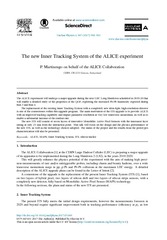The new Inner Tracking System of the ALICE experiment
Acharya, Shreyasi; Adam, Jaroslav; Adamová, Dagmar; Adolfsson, Jonatan; Aggarwal, Madan M.; Aglieri Rinella, G; Agnello, Michelangelo; Agrawal, Nikita; Ahammed, Zubayer; Ahmad, N; Ahn, SU; Alme, Johan; Altenkaemper, Lucas; Arsene, Ionut Christian; Bätzing, Paul Christoph; Djuvsland, Øystein; Dordic, Olja; Helstrup, Håvard; Hetland, Kristin Fanebust; Kileng, Bjarte; Langøy, Rune; Lardeux, Antoine Xavier; Lien, Jørgen André; Lindal, Svein; Lønne, Per-Ivar; Mahmood, Sohail Musa; Milosevic, Jovan; Nesbø, Simon Voigt; Nystrand, Joakim; Rehman, Attiq Ur; Richter, Matthias Rudolph; Røed, Ketil; Røhrich, Dieter; Skaali, Toralf Bernhard; Tambave, Ganesh Jagannath; Tveter, Trine Spedstad; Ullaland, Kjetil; Velure, Arild; Wagner, Boris; Wikne, Jon Christopher; Zhang, Hui; Zhao, Chengxin; Zhou, Zhuo; Zhu, Hongsheng; Qvigstad, Henrik; Aiola, Salvatore; Akindinov, Alexander; Alam, Sk Noor; Alba, José Luis Bazo; Aleksandrov, Dimitry; Allesandro, B.; ALICE, Collaboration
Peer reviewed, Journal article
Published version

Åpne
Permanent lenke
https://hdl.handle.net/1956/17985Utgivelsesdato
2017-11Metadata
Vis full innførselSamlinger
Originalversjon
https://doi.org/10.1016/j.nuclphysa.2017.05.069Sammendrag
The ALICE experiment will undergo a major upgrade during the next LHC Long Shutdown scheduled in 2019–20 that will enable a detailed study of the properties of the QGP, exploiting the increased Pb-Pb luminosity expected during Run 3 and Run 4. The replacement of the existing Inner Tracking System with a completely new ultra-light, high-resolution detector is one of the cornerstones within this upgrade program. The main motivation of the ITS upgrade is to provide ALICE with an improved tracking capability and impact parameter resolution at very low transverse momentum, as well as to enable a substantial increase of the readout rate. The new ITS will consist of seven layers of innovative Monolithic Active Pixel Sensors with the innermost layer sitting at only 23 mm from the interaction point. This talk will focus on the design and the physics performance of the new ITS, as well as the technology choices adopted. The status of the project and the results from the prototypes characterization will also be presented.
